Abstract
Hyperfiltration, which has been implicated in the early stages of development of chronic kidney disease (CKD) in diabetes mellitus, is a common finding in sickle cell anemia (SCA) patients with normal kidney function. We hypothesized that it may be a risk factor for the development of microalbuminuria, an early indicator of glomerular injury that is observed in 40-60% of adult patients with sickle cell anemia (SCA).
In the cross-sectional analysis, 233 adult SCA patients treated at the University of Illinois at Chicago Sickle Cell Center with baseline estimated glomerular filtration rates (eGFR) determined by the MDRD equation and albuminuria concentrations were screened. Data was collected from steady-state visits defined as four weeks from a vaso-occlusive pain episode or red blood cell transfusion. Eight-two patients with normoalbuminuria (urine albumin concentration < 30mg/g creatinine) and an eGFR ≥ 90mL/min/1.73m2 were evaluated of which 38 (46%) had normal eGFR (defined as eGFR 90-150mL/min/1.73m2) and 44 (54%) had hyperfiltration (defined as eGFR >150mL/min/1.73 m2). On univariate analysis, the median age of patients with hyperfiltration was 23 years compared to 34 years in patients with a normal eGFR (p<0.0001). Additionally, patients with hyperfiltration had lower hemoglobin F concentrations (3.9 vs. 7.3%, p=0.01) and higher absolute reticulocyte counts (390 vs. 288 x103/µL, p=0.03) than patients with normal eGFR, respectively. On multivariate analysis, hyperfiltration was independently associated with age (OR 0.9, 95% CI: 0.8-0.9; p=0.0001) and the natural log of hemoglobin F concentration (OR 0.5, 95% CI: 0.2-1.0; p=0.04).
Forty-six patients with normoalbuminuria and eGFR ≥ 90mL/min/1.73m2 were followed longitudinally for progression to microalbuminuria. At a median follow up of 30 months (range 1-81 months), 35% (16/46) of patients developed microalbuminuria with a mean time to progression of 49 months (range 11-57 months). The average time to develop microalbuminuria in patients with hyperfiltration was 33 months (42%, 11/26) compared to 62 months in patients with normal eGFR (25%, 5/20) (age-adjusted HR 4.0, 95% CI 1.5 – 10.4; log-rank p=0.016) (Figure 1).
In summary, hyperfiltration in SCA patients with normoalbuminuria was associated with younger age and lower hemoglobin F concentration on cross sectional analysis and with higher rates of progression to microalbuminuria on longitudinal analysis. Future research to better understand the development of hyperfiltration and its contribution to kidney damage may help guide future therapies for sickle cell nephropathy.
No relevant conflicts of interest to declare.
Author notes
Asterisk with author names denotes non-ASH members.


